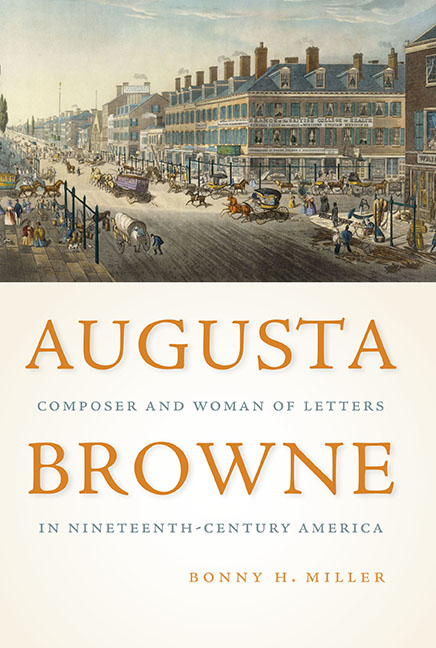Book contents
- Frontmatter
- Contents
- List of Illustrations
- Preface
- Acknowledgments
- Introduction
- 1 First Steps
- 2 Apprentice in a Family Music Business
- 3 Philadelphia Debut
- 4 A Young Professor of Music
- 5 A New Leaf
- 6 Her Own Woman
- 7 Courtship and Consequences
- 8 Pilgrim in Progress
- 9 “Glad Fruition”
- 10 Legacy in Music
- 11 Legacy in Literature
- 12 Contributions to Music Journalism
- 13 A Legacy Written into History
- Appendixes
- Appendixe 1 Children and Descendants of David Samuel Browne and Elizabeth Montgomery Browne
- Appendixe 2 Chronology of Augusta Browne’s Music and Letters
- Appendixe 3 List of Musical Works
- Appendix 4 Selected Glossary
- List of Abbreviations
- Notes
- Selected Bibliography
- Index
7 - Courtship and Consequences
Published online by Cambridge University Press: 23 October 2020
- Frontmatter
- Contents
- List of Illustrations
- Preface
- Acknowledgments
- Introduction
- 1 First Steps
- 2 Apprentice in a Family Music Business
- 3 Philadelphia Debut
- 4 A Young Professor of Music
- 5 A New Leaf
- 6 Her Own Woman
- 7 Courtship and Consequences
- 8 Pilgrim in Progress
- 9 “Glad Fruition”
- 10 Legacy in Music
- 11 Legacy in Literature
- 12 Contributions to Music Journalism
- 13 A Legacy Written into History
- Appendixes
- Appendixe 1 Children and Descendants of David Samuel Browne and Elizabeth Montgomery Browne
- Appendixe 2 Chronology of Augusta Browne’s Music and Letters
- Appendixe 3 List of Musical Works
- Appendix 4 Selected Glossary
- List of Abbreviations
- Notes
- Selected Bibliography
- Index
Summary
New York City was at the height of an art boom during the 1850s, with excellent opportunities to view or display works through organizations of artists and associated galleries. Augusta Browne's contacts included artists from the National Academy of Design, the Brooklyn Institute, and the American Art-Union. She continued to benefit from connections she had made through her brother Hamilton and his friend and fellow art student Walter Libbey. The composer often referred to a sisterhood of arts—music, visual arts, literature—a common theme in the middle of the nineteenth century that also was articulated by Walt Whitman, who was likewise drawn to the artistic circles of Brooklyn and Manhattan.
Exactly how and when Augusta met the recently arrived painter John Walter Benjamin Garrett is uncertain. They could easily have met at a gallery event. Augusta was five or six years older than the artist, but a whirlwind courtship culminated in a wedding within weeks. At thirty-five, Augusta was well established in her career and did not have many childbearing years left. Marriage no longer presented the risk of overwhelming her professional activities with the needs of childcare. The New-York Daily Times announced the marriage: “on Thursday, 20 Sept. [1855], at the residence of the bride's father … Miss Augusta Browne to Mr. J. W. B. Garrett, Esq.” The Home Journal elaborated, “Miss Augusta Browne, the well-known and distinguished musical composer and authoress, of this city, to J. W. B. Garrett, a distinguished young artist of Memphis, Tennessee.” A Philadelphia fashion plate issued in 1855 suggests how a home wedding in the Browne parlor might have looked (fig. 7.1).
Becoming a bride so late demonstrated that Augusta still had the looks, style, and wit to defy the old maxim that women who tarry may never marry. Previously unmarried women in their thirties often wedded an older widower with children during the antebellum period. The union of a spinster and a younger man presented a promising subject for gossip and speculation, but the fastidious assertion that the marriage took place in her father's home provided a seal of respectability.
- Type
- Chapter
- Information
- Augusta BrowneComposer and Woman of Letters in Nineteenth-Century America, pp. 144 - 159Publisher: Boydell & BrewerPrint publication year: 2020



